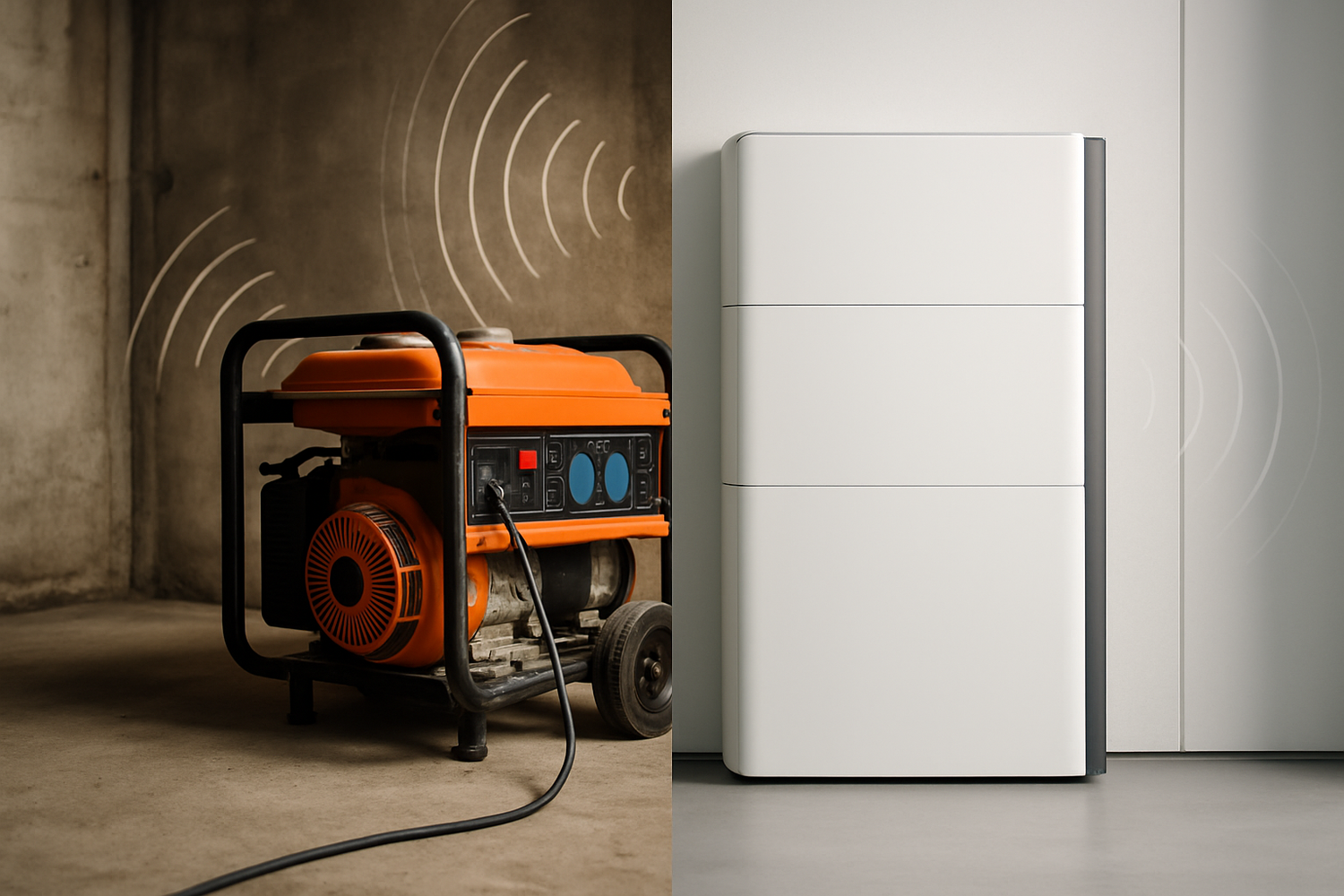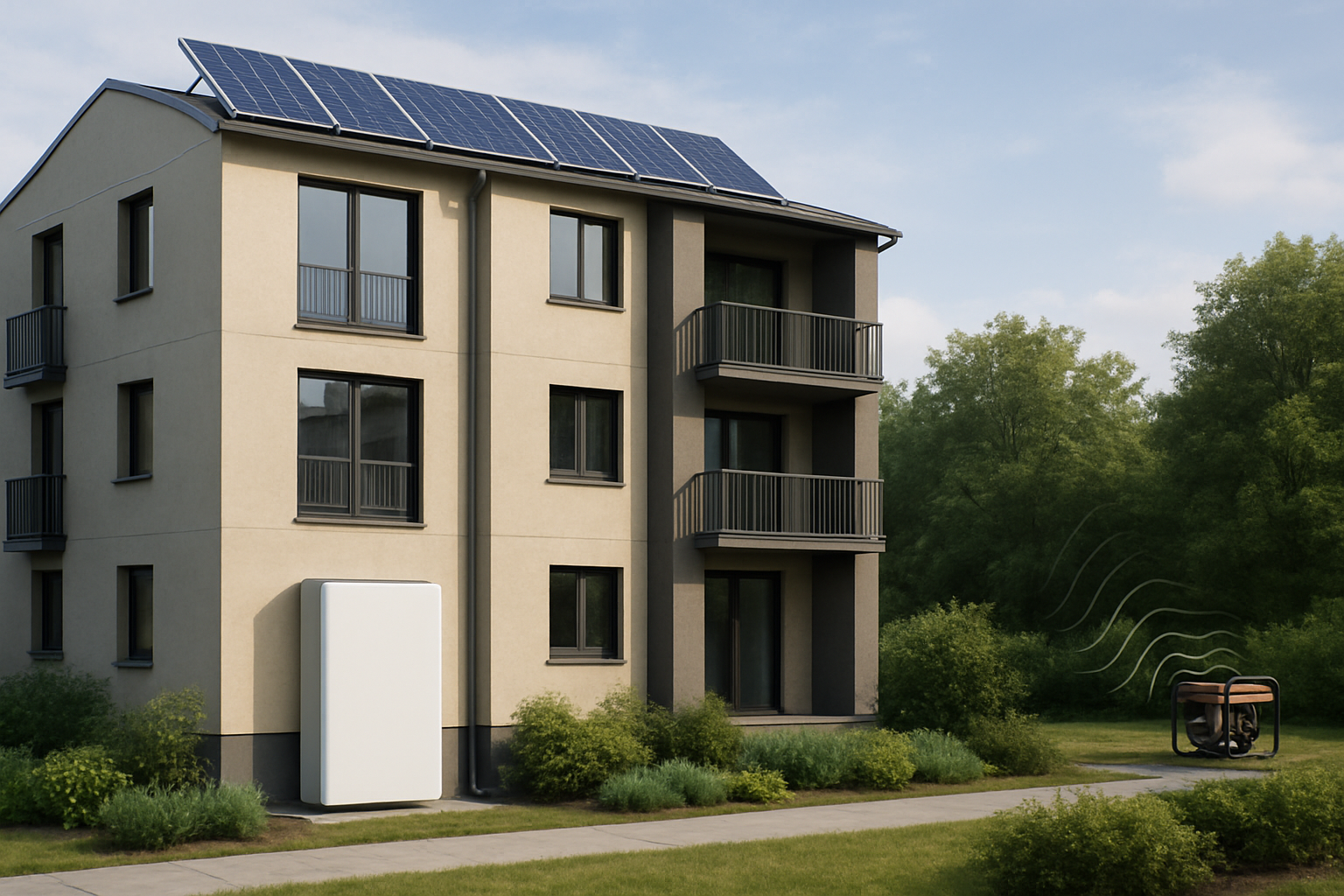Living or working in noise-sensitive environments presents unique challenges for power generation. Traditional gas generators, while offering backup power, often introduce significant noise pollution. This noise impacts comfort, productivity, and adherence to local regulations. Energy Storage Systems (ESS), powered by solar or grid charging, offer a compelling alternative. This document examines the distinct noise profiles of gas generators and modern ESS, providing data-backed insights into why ESS stands as a superior solution for indoor, noise-conscious applications.
Understanding Noise in Residential and Commercial Settings
Noise, often an overlooked pollutant, significantly affects human well-being. Prolonged exposure to high decibel levels can lead to stress, sleep disruption, and decreased concentration. In residential areas, excessive noise from power sources can strain neighbor relations and violate local ordinances. Commercial spaces, such as offices, healthcare facilities, or educational institutions, require quiet environments to function effectively.
The Impact of Noise Pollution
The World Health Organization (WHO) identifies noise pollution as a major public health concern. Continuous exposure to noise levels above 55 dB (decibels) during the day can lead to annoyance and health issues. At night, levels above 40 dB can disrupt sleep. Indoor environments, with their enclosed spaces, can amplify noise, making even moderately loud sources problematic. For instance, a typical conversation occurs around 60 dB, while a quiet library sits at about 30 dB. Introducing a loud power source into these settings drastically alters the acoustic landscape.
Regulatory Landscape for Indoor Noise
Many cities and municipalities enforce strict noise ordinances, particularly in residential and mixed-use zones. These regulations often specify maximum permissible decibel levels during certain hours, both outdoors and indoors. Non-compliance can result in fines and legal actions. For indoor power solutions, meeting these regulations is paramount, especially in multifamily dwellings or commercial buildings where quiet operation is a necessity. Adhering to these codes ensures peace and compliance.
Gas Generators: The Sound of Power
Gas generators operate on the principle of internal combustion, converting fuel into mechanical energy to produce electricity. This process inherently generates substantial noise, primarily from the engine, exhaust, and cooling fan. Their design prioritizes power output, often at the expense of quiet operation.
Typical Noise Profiles of Gas Generators
The noise output of gas generators varies based on their size, power rating, and enclosure. Smaller, portable models typically produce noise levels ranging from 65 dB to 85 dB when measured at a distance of 7 meters (approximately 23 feet). Larger, industrial-grade generators can exceed 90 dB. To put this in perspective, 70 dB is comparable to a vacuum cleaner, and 85 dB is similar to heavy city traffic or a noisy restaurant. Operating such a device indoors, even with soundproofing, presents a considerable challenge for noise mitigation.
Factors Influencing Generator Noise
- Engine Size and Type: Larger engines and those with more cylinders generally produce more noise.
- Exhaust System: An inefficient or uninsulated exhaust system contributes significantly to overall noise.
- Cooling Fan: High-speed fans required to cool the engine can generate a loud whirring sound.
- Enclosure and Insulation: Open-frame generators are louder than those with sound-attenuating enclosures. However, even enclosed models have limitations for indoor use.
- Load: Generators tend to be louder when operating under a heavier electrical load.
Challenges of Indoor Gas Generator Use
Beyond noise, operating gas generators indoors poses severe safety risks. They produce carbon monoxide, a colorless, odorless, and deadly gas, necessitating extensive ventilation that is often impractical or impossible in confined indoor spaces. Fuel storage indoors also presents fire hazards. These safety concerns, combined with the inherent noise, make gas generators unsuitable for most indoor, noise-sensitive applications.

Energy Storage Systems (ESS): The Quiet Revolution
Energy Storage Systems (ESS), particularly those utilizing lithium iron phosphate (LiFePO4) batteries, represent a significant leap forward in quiet, efficient power. Unlike combustion-based generators, ESS stores electrical energy chemically, releasing it on demand without burning fuel.
How ESS Minimizes Noise
The fundamental difference lies in the operating principle. ESS does not have internal combustion engines, exhaust systems, or large, noisy cooling fans for combustion. The primary components that might generate sound are the inverter and battery management system, which may have small, low-speed cooling fans that activate only when necessary. This design inherently leads to significantly lower noise output.
Noise Profiles of Modern ESS
Modern home energy storage systems typically operate at noise levels ranging from 25 dB to 45 dB, measured at a distance of 1 meter. This range is comparable to a quiet whisper (20 dB) or the hum of a refrigerator (35-40 dB). Many systems are designed to be virtually silent during normal operation, with fans only engaging during peak charging or discharging cycles, and even then, at very low decibel levels. This makes them ideal for installation within residential living spaces, garages, or utility rooms without causing disturbance.
Advantages of ESS for Noise-Sensitive Environments
Beyond minimal noise, ESS offers numerous benefits for indoor applications:
- Zero Emissions: No harmful fumes like carbon monoxide, making them safe for indoor installation without complex ventilation.
- Low Maintenance: Fewer moving parts mean less wear and tear and reduced maintenance requirements compared to generators.
- Energy Independence: When paired with solar panels, ESS provides a pathway to significant energy independence, reducing reliance on the grid.
- Seamless Integration: Home energy storage systems integrate smoothly with existing electrical infrastructure, offering automatic backup power during outages.
Data-Backed Comparison: Gas Generators vs. ESS
A direct comparison of noise levels highlights the stark difference between gas generators and ESS, especially for indoor use.
Decibel Levels: A Direct Look
The following table illustrates typical noise levels for both power sources:
| Power Source | Typical Noise Level (dB) | Common Sound Equivalent | Suitability for Indoor Use |
|---|---|---|---|
| Gas Generator (Portable) | 65 - 85 dB (at 7 meters) | Vacuum cleaner, heavy traffic | Not suitable (noise, emissions) |
| Energy Storage System (ESS) | 25 - 45 dB (at 1 meter) | Whisper, refrigerator hum | Highly suitable (minimal noise, no emissions) |
This data clearly shows that ESS operates at noise levels significantly below those of gas generators, making them a far more comfortable and compliant option for indoor environments. According to the U.S. Energy Information Administration (EIA), the shift towards cleaner, quieter energy sources is a growing trend, aligning with the capabilities of ESS.
Long-Term Noise Impact and Operational Costs
Beyond immediate noise, the long-term impact on occupants and operational costs differ greatly. Constant exposure to generator noise can lead to chronic stress and reduced quality of life. For businesses, it can deter customers and reduce employee productivity. ESS, with its quiet operation, preserves the indoor environment, contributing to well-being and operational efficiency.
From an economic perspective, gas generators require continuous fuel purchases and regular maintenance, including oil changes, spark plug replacements, and filter cleaning. These costs add up over time. In contrast, ESS, especially when integrated with solar panels, leverages free solar energy. While the initial investment in an ESS may be higher, the absence of fuel costs and significantly lower maintenance requirements often lead to substantial long-term savings. The International Renewable Energy Agency (IRENA) highlights the decreasing costs of battery storage, making these systems increasingly economically viable.
The Path Forward for Quiet Power
For individuals and organizations seeking reliable indoor power in noise-sensitive areas, the choice is clear. Energy Storage Systems offer a quiet, clean, and efficient alternative to traditional gas generators. They eliminate the noise pollution, emission hazards, and fuel dependency associated with combustion engines. By embracing advanced battery technology, you gain peace of mind, comply with noise regulations, and achieve greater energy independence. This shift represents a move towards more sustainable and comfortable living and working environments.
Frequently Asked Questions
Are all ESS truly silent?
Most modern ESS are designed for very quiet operation. While they are not absolutely silent (some may have low-level fan noise during high-demand periods), their noise output is typically comparable to ambient household sounds, far below that of gas generators. The noise levels are generally between 25-45 dB, which is barely noticeable in most indoor settings.
Can an ESS power an entire home?
Yes, depending on its capacity and your home's energy consumption. Home energy storage systems are scalable and can be configured to provide partial or whole-home backup power. Consulting with an energy specialist helps determine the right size for your specific needs.
How long can an ESS power my home during an outage?
The duration depends on the battery capacity and your energy usage during the outage. A larger battery bank will provide power for a longer period. If integrated with solar panels, the system can recharge during daylight hours, extending the backup duration indefinitely, provided there is sufficient sunlight.
Is indoor installation of ESS safe?
Yes, modern ESS, particularly those using LiFePO4 batteries, are designed with multiple safety features, including advanced battery management systems (BMS) that prevent overcharging, over-discharging, and overheating. They produce no harmful emissions, making them safe for indoor installation in designated areas like utility rooms or garages.
What is the lifespan of an ESS?
LiFePO4 batteries, commonly used in ESS, are known for their long cycle life, often lasting 10 to 15 years or more, depending on usage and environmental conditions. Many manufacturers offer warranties reflecting this extended lifespan.
References
- U.S. Energy Information Administration (EIA). Electricity Explained: Power Plants. Accessed August 22, 2025.
- International Renewable Energy Agency (IRENA). Solar Energy. Accessed August 22, 2025.
- U.S. Department of Energy. Solar Energy. Accessed August 22, 2025.
- International Energy Agency (IEA). Energy Storage. Accessed August 22, 2025.





Leave a comment
All comments are moderated before being published.
This site is protected by hCaptcha and the hCaptcha Privacy Policy and Terms of Service apply.